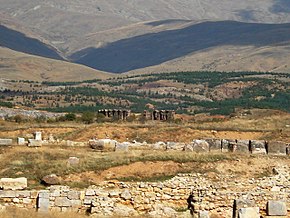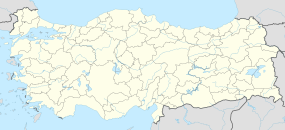Antiochia in Pisidia

Ruins at Antioch of Pisidia
|
|
| Alternate name | Antiochia in Pisidia, Pisidian Antioch, Antiochia Caesareia, Antiochia Caesarea, Antiochia in Phrygia |
|---|---|
| Location | Isparta Province, Turkey |
| Region | Pisidia |
| Coordinates | 38°18′22″N 31°11′21″E / 38.30611°N 31.18917°ECoordinates: 38°18′22″N 31°11′21″E / 38.30611°N 31.18917°E |
| Type | Settlement |
| History | |
| Cultures | Seleucid, Roman, Byzantine, Turkish |
| Site notes | |
| Condition | In ruins |
Antioch in Pisidia – alternatively Antiochia in Pisidia or Pisidian Antioch (Greek: Ἀντιόχεια τῆς Πισιδίας) and in Roman Empire, Latin: Antiochia Caesareia or Antiochia Colonia Caesarea – is a city in the Turkish Lakes Region, which is at the crossroads of the Mediterranean, Aegean and Central Anatolian regions, and formerly on the border of Pisidia and Phrygia, hence also known as Antiochia in Phrygia. The site lies approximately 1 km northeast of Yalvaç, the modern town of Isparta Province. The city is on a hill with its highest point of 1236 m in the north.
The city is surrounded by, on the east the deep ravine of the Anthius River which flows into Lake Eğirdir, with the Sultan Mountains to the northeast, Mount Karakuş to the north, Kızıldağ (Red Mountain) to the southeast, Kirişli Mountain and the northern shore of Lake Eğirdir to the southwest.
Although very close to Mediterranean on the map, the warm climate of the south cannot pass the height of the Taurus Mountains. Owing to the climate, there is no timberland but crop plants grow in areas provided with water from the Sultan Mountains, whose annual average rainfall is c. 1000 mm on the peaks and 500 mm on the slopes. This water feeds the plateau and Antioch. The other Pisidian cities Neapolis, Tyriacum, Laodiceia Katakekaumene and Philomelium founded on the slopes, benefited from this fertility.
The acropolis has an area of 460,000 square metres (115 acres) and is surrounded by fortified defence walls. The Territorium of the settlement can be seen from the Temple of Men in the sanctuary of Men Askaenos on a hill to the southeast. The Territorium of the city is estimated to have been approximately 1,400 km² in ancient times. According to the 1950 census, there were 40 villages with 50,000 people living in the area. The population during the Roman period must have been a little more than this.
...
Wikipedia

